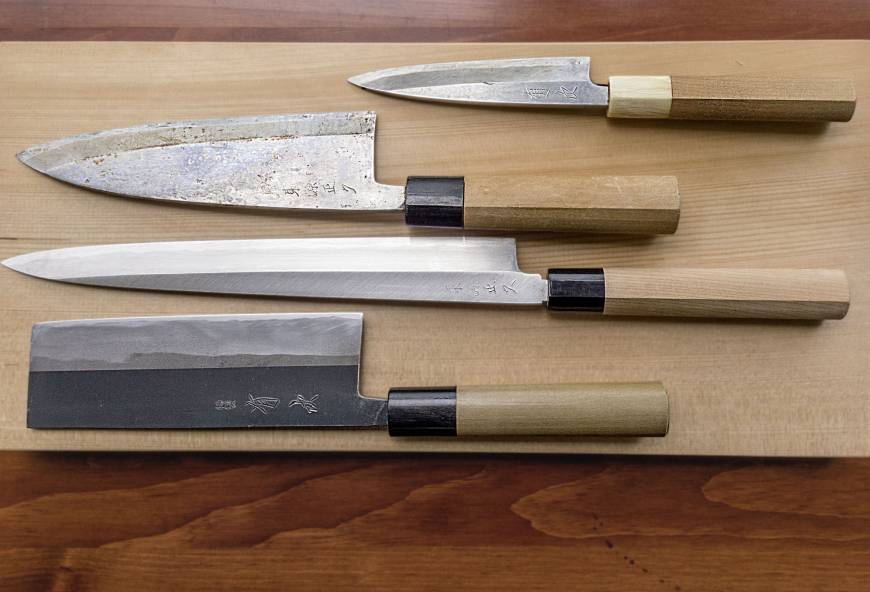Japanese kitchen knives have a worldwide reputation for excellent quality and artistic beauty. The trouble is, there’s so much mythology and romance surrounding them, not to mention a bewilderingly wide range of prices and types, that it can be difficult to make a choice.
The first thing you should ask yourself is how much time and effort you’re willing to put into taking care of your knives. The answer to this will dictate the knife material you should choose.
Japanese knives are traditionally made with a type of carbon steel called hagane, which comes in various gradations. Cutting implements made with hagane can hold an extremely sharp edge, which is why this material was also used to forge Nihontō (samurai swords). However, hagane is a relatively soft steel that’s meant to be maintained regularly; professional chefs sharpen and take care of their knives every day, but a hagane blade that’s not maintained regularly will dull, chip and rust.
Stainless steel, on the other hand, is very easy to maintain; it doesn’t rust and holds a sharp edge for long time. Once a stainless steel blade loses its edge, it takes some effort and skill to sharpen properly, so many people prefer to have them professionally sharpened. (I’ll stick to discussing steel knives here due to space constraints, but ceramic knives are also available. Personally I think ceramic is best suited for small paring knives and the like.)
The other major consideration when looking at knives is whether to choose a single- or double-bevel blade. Most traditional Japanese-style knives have a wide, deep-angle bevel on one side of the blade, while Western-style knives as well as the most popular modern Japanese knife types have a shallow, narrow bevel on both sides of the blade. Double-bevel knives are also generally thinner and lighter than single-bevel knives of similar size.
For home use, a double-bevel blade is usually easier to handle, and they aren’t too difficult to sharpen with a little practice. If you are left-handed, keep in mind that regular single-bevel knives are meant for use in your right hand only — left-handed single bevels are rare and expensive.
For the typical home kitchen, however, the knife or knives you use the most should be either all stainless steel or hagane-clad stainless steel with double bevel blades. If you want a sturdy knife that can do everything from breaking down meat or fish to chopping vegetables, go for a chef’s knife, which is called a gyūtō (cow knife).
If you prefer lighter, thinner knives, a santoku bōchō is a great choice. Santokumeans “three virtues,” indicating that it can be used for meat, fish and vegetables. Another useful blade is a smaller version of the santoku called a petty knife, which is great for fine cutting tasks or general chopping, especially if you have small hands. Serrated bread knives are popular in Japan these days, too.
My fourth favorite knife is the nakiri or vegetable-cutting knife, which has a square, thin, double-bevel blade. Other knives include the deba, a single-bevel pointed knife that’s used for breaking down fish and meat; a smaller version of the deba called the ajikiri, used for small fish like Pacific saury (aji); and the long, thin, elegant yanagiba (willow blade), with which one can delicately slice fish for sashimi and sushi.
And while the sky’s the limit when it comes to the price for a top-quality, hand-forged knife, you can get decent quality ones for just few thousand yen.
By far the best knife-related investment you can make, however, is learning how to properly sharpen your blades. I use a #1000 or #1500 whetstone for sharpening, and a #5000 for polishing the blade — this combination works for all my knives. Online sharpening how-to videos are a place to start — or better yet, get someone to show you how.
2017年5月27日付のJAPAN TIMESで上記に記事が掲載された。要約すると、以下のようになる。
- 日本の料理用ナイフ(包丁)の品質はすばらしく、芸術品である。それは世界的にも知られている。
- ただし、手入れを怠ると、切れ味は鈍くなるし、刃こぼれはするし、ついにはほころびてしましまう。
- 用途に合わせた何種類かの包丁がある。包丁の購入はあなたのメンテナンス技術や包丁の値段による。
- まずは正しい包丁の研ぎ方をオンラインビデオ―実際に誰かに見せてもらうのがもっと良い―で学ぶとよい。
上記記事からの結論は、メンテナンスは面倒だが日本の包丁はすばらしい。メンテナンス技術は必ず学んでね。ということである。メンテンナンスの出来ていない包丁は、切れない、危ない、汚い、である。なかでも、見た目がとくに醜くくなる。これは、ただの鉄くずにすぎない。芸術品にするかゴミにするかはあなたのメンテナンス技術次第である。
以下にビデオで学んでいただきたい。
(Translation)
The article was published at the JAPAN TIMES dated May 27, 2017. In summary, it becomes as follows.
The quality of Japanese cooking knives (knives) is wonderful, it is a work of art. It is also known worldwide.
However, if you do not clean, the sharpness will become dull, the blade will spill, and it will eventually crush.
There are several kinds of kitchen knives suitable for the application. Purchase of kitchen knife depends on your maintenance technology and price of kitchen knife.
First of all, learn how to sharpen the correct kitchen knife with online video – better to show someone actually.
The conclusion from the above article is maintenance troublesome, but Japanese knives are wonderful. Be sure to learn maintenance technology. That’s what it means. A kitchen knife without mentenance can not be cut, dangerous, dirty. Especially, it looks particularly ugly. This is just iron scrap. Whether it is a work of art or garbage is up to your maintenance skill.
Please learn the video below.
Made in Japan ! How to sharpen a Sashimi-bocho (for any knives).English Version. 『刺し身包丁』の研ぎ方・英語字 from 向山仁志 on Vimeo.


